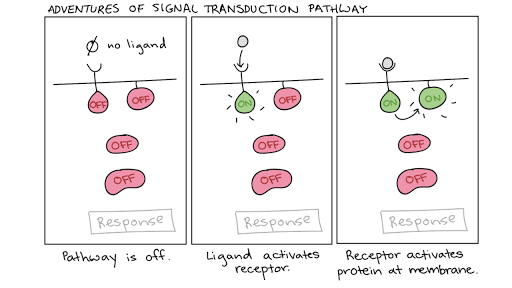Which Best Describes a Signal Transduction Pathway
Signal transduction by CAMP happens as Adenylyl cyclase converts ATP into cAMP by removing two phosphates from it. Which of the following best describes the component that metformin represents in a signal transduction pathway that regulates glucose production in the liver.
Numbered 1-5 in a signal transduction pathway that utilizes a G protein-coupled receptor.
. Which of the following best describes how the response would be affected if the molecular changes that occur during a signaling pathway lasted for a prolonged period. In a signal transduction pathway fine tuning of the cellular response occurs in several steps. The signal-receptor complex activates a G protein.
B It acts as a receptor. CAMP activates protein kinase A thereby allowing the target cells to be phosphorylated and then pass the signal. The signal-receptor complex activated a G protein 5.
A signal molecule binds to a receptor. Based on the information provided which of the following best describes the role of insulin in this liver cell signal transduction pathway. The ligand initiates a kinase cascade by transferring a phosphate group onto the JAK protein.
Inactivation mechanisms would be triggered before the pathway could be completed. Signal transduction pathway involves the binding of extracellular signaling molecules and ligands to receptors located on the cell surface or inside the cell that trigger events inside the cell to invoke a response. The endocrine system incorporates feedback mechanisms that maintain homeostasis.
The chains of molecules that relay signals inside a cell are known as intracellular signal transduction pathways. A G protein is inactivated by hydrolysis of bound GTP. Which of the following demonstrates negative feedback by the endocrine system.
Introduction to Signal Transduction. A cascade of events or biochemical changes within the cell. Protein kinases are activated.
In a certain signal transduction pathway the binding of an extracellular molecule to a cell-surface protein results in a rapid increase in the concentration of cyclic AMPAMP inside the cell. Elaborate the role of molecular circuits in signal transmission and their regulation. The cyclic AMPAMP binds to and activates cytosolic enzymes that then activate other enzymes in.
It acts as a ligand. Here well look at the general characteristics of intracellular signal transduction pathways as well as some relay mechanisms commonly used in these pathways. Explain the role of G-proteins receptor dimerization tyrosine kinases and calcium in intracellular signaling Illustrate how insulin.
C It acts as a secondary messenger. Which of the following statements is not true of the JAK-STAT signal transduction pathway. CAMP signaling is turned off by enzymes called phosphodiesterases the cAMP ring is broken down into adenosine.
D It acts as a protein kinase. A It acts as a ligand. Which of the following statements best describes a key aspect of a G protein signaling pathway.
Signaling pathways in multicellular organisms are triggered by various environmental stimuli. Signal transmission is caused either by. Target proteins are phosphorylated.
The activated EGFR triggers a signal transduction pathway which leads to increased frequency of cell division. Which of the following best describes a signal transduction pathway. A signal molecule 1.
Describe in the signal transduction pathways involved in cell signaling. Signal Transduction transmission of molecular signals from outside the cell into the cell via cell-surface receptors. Receptor dimerization is required for autophosphorylation.
A binding of a signal molecule to a cell protein B catalysis mediated by an enzyme C sequence of changes in a series of molecules resulting in a response D binding of a ligand on one side of a membrane that results in a change on the other side E the cells detection of a chemical or mechanical stimulus. Based on the information provided which of the following best describes the role of insulin in this liver cell signal transduction pathway. The assignment requested is as follows.
O receptors that initiate biochemical changes accomplish this either by intrinsic. Which of the sequences below best describes the sequential steps numbered 1-5 in a signal transduction pathway that utilizes a G protein-coupled receptor. When a growth factor binds to EGFR the receptor is activated.
JAK is both a protein kinase and a target of phosphorylation.

Signal Transduction Pathway Cell Signaling Article Khan Academy
No comments for "Which Best Describes a Signal Transduction Pathway"
Post a Comment